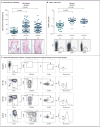Eltrombopag Added to Standard Immunosuppression for Aplastic Anemia
- PMID: 28423296
- PMCID: PMC5548296
- DOI: 10.1056/NEJMoa1613878
Eltrombopag Added to Standard Immunosuppression for Aplastic Anemia
Abstract
Background: Acquired aplastic anemia results from immune-mediated destruction of bone marrow. Immunosuppressive therapies are effective, but reduced numbers of residual stem cells may limit their efficacy. In patients with aplastic anemia that was refractory to immunosuppression, eltrombopag, a synthetic thrombopoietin-receptor agonist, led to clinically significant increases in blood counts in almost half the patients. We combined standard immunosuppressive therapy with eltrombopag in previously untreated patients with severe aplastic anemia.
Methods: We enrolled 92 consecutive patients in a prospective phase 1-2 study of immunosuppressive therapy plus eltrombopag. The three consecutively enrolled cohorts differed with regard to the timing of initiation and the duration of the eltrombopag regimen (cohort 1 received eltrombopag from day 14 to 6 months, cohort 2 from day 14 to 3 months, and cohort 3 from day 1 to 6 months). The cohorts were analyzed separately. The primary outcome was complete hematologic response at 6 months. Secondary end points included overall response, survival, relapse, and clonal evolution to myeloid cancer.
Results: The rate of complete response at 6 months was 33% in cohort 1, 26% in cohort 2, and 58% in cohort 3. The overall response rates at 6 months were 80%, 87%, and 94%, respectively. The complete and overall response rates in the combined cohorts were higher than in our historical cohort, in which the rate of complete response was 10% and the overall response rate was 66%. At a median follow-up of 2 years, the survival rate was 97%; one patient died during the study from a nonhematologic cause. Marked increases in bone marrow cellularity, CD34+ cell number, and frequency of early hematopoietic progenitors were noted. Rates of relapse and clonal evolution were similar to our historical experience. Severe rashes occurred in two patients, resulting in the early discontinuation of eltrombopag.
Conclusions: The addition of eltrombopag to immunosuppressive therapy was associated with markedly higher rates of hematologic response among patients with severe aplastic anemia than in a historical cohort. (Funded by the National Heart, Lung, and Blood Institute; ClinicalTrials.gov number, NCT01623167 .).
Figures


References
-
- Camitta BM. Criteria for severe aplastic anaemia. Lancet. 1988;1:303–4. - PubMed
-
- Frickhofen N, Kaltwasser JP, Schrezenmeier H, et al. Treatment of aplastic anemia with antilymphocyte globulin and methylprednisolone with or without cyclosporine. N Engl J Med. 1991;324:1297–304. - PubMed
-
- Rosenfeld SJ, Kimball J, Vining D, Young NS. Intensive immunosuppression with antithymocyte globulin and cyclosporine as treatment for severe acquired aplastic anemia. Blood. 1995;85:3058–65. - PubMed
Publication types
MeSH terms
Substances
Associated data
Grants and funding
LinkOut - more resources
Full Text Sources
Other Literature Sources
Medical
